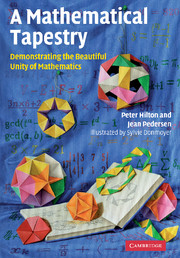Book contents
- Frontmatter
- Contents
- Preface
- Acknowledgments
- 1 Flexagons – A beginning thread
- 2 Another thread – 1-period paper-folding
- 3 More paper-folding threads – 2-period paper-folding
- 4 A number-theory thread – Folding numbers, a number trick, and some tidbits
- 5 The polyhedron thread – Building some polyhedra and defining a regular polyhedron
- 6 Constructing dipyramids and rotating rings from straight strips of triangles
- 7 Continuing the paper-folding and number-theory threads
- 8 A geometry and algebra thread – Constructing, and using, Jennifer's puzzle
- 9 A polyhedral geometry thread – Constructing braided Platonic solids and other woven polyhedra
- 10 Combinatorial and symmetry threads
- 11 Some golden threads – Constructing more dodecahedra
- 12 More combinatorial threads – Collapsoids
- 13 Group theory – The faces of the trihexaflexagon
- 14 Combinatorial and group-theoretical threads – Extended face planes of the Platonic solids
- 15 A historical thread – Involving the Euler characteristic, Descartes' total angular defect, and Pólya's dream
- 16 Tying some loose ends together – Symmetry, group theory, homologues, and the Pólya enumeration theorem
- 17 Returning to the number-theory thread – Generalized quasi-order and coach theorems
- References
- Index
5 - The polyhedron thread – Building some polyhedra and defining a regular polyhedron
Published online by Cambridge University Press: 10 November 2010
- Frontmatter
- Contents
- Preface
- Acknowledgments
- 1 Flexagons – A beginning thread
- 2 Another thread – 1-period paper-folding
- 3 More paper-folding threads – 2-period paper-folding
- 4 A number-theory thread – Folding numbers, a number trick, and some tidbits
- 5 The polyhedron thread – Building some polyhedra and defining a regular polyhedron
- 6 Constructing dipyramids and rotating rings from straight strips of triangles
- 7 Continuing the paper-folding and number-theory threads
- 8 A geometry and algebra thread – Constructing, and using, Jennifer's puzzle
- 9 A polyhedral geometry thread – Constructing braided Platonic solids and other woven polyhedra
- 10 Combinatorial and symmetry threads
- 11 Some golden threads – Constructing more dodecahedra
- 12 More combinatorial threads – Collapsoids
- 13 Group theory – The faces of the trihexaflexagon
- 14 Combinatorial and group-theoretical threads – Extended face planes of the Platonic solids
- 15 A historical thread – Involving the Euler characteristic, Descartes' total angular defect, and Pólya's dream
- 16 Tying some loose ends together – Symmetry, group theory, homologues, and the Pólya enumeration theorem
- 17 Returning to the number-theory thread – Generalized quasi-order and coach theorems
- References
- Index
Summary
An intuitive approach to polyhedra
In Chapter 3 we looked at polygons in the plane, and in particular, we studied, there and in Chapter 2, how to construct some regular convex polygons. A natural extension of this idea in 3 dimensions is to study how to construct polyhedra, which are, in an obvious way, the 3-dimensional analogs of polygons. For example, just as a connected polygon divides the plane into two regions (the inside and the outside), a connected polyhedron divides space into two regions (again, the inside and outside). A polygon consists of straight (uncurved) sides, that is, parts of lines, whereas a polyhedron consists of flat (uncurved) faces, that is, parts of planes. A rectangular box is an example of a polyhedron, but a cylindrical can is not because its boundary does not consist entirely of flat faces.
The formal study of polyhedra is very rich and intellectually rewarding, but we will restrain ourselves and postpone our general discussions of the mathematics of polyhedra, which is by no means exhaustive, until Chapters 9, 14, and 15. Here, and in Chapter 8, we study polyhedra from the practical, constructive point of view. We think this is the appropriate order of events. If you choose to build the models we describe, you will discover that making them is a vivid educational experience, particularly if you have never built polyhedral models before.
Information
- Type
- Chapter
- Information
- A Mathematical TapestryDemonstrating the Beautiful Unity of Mathematics, pp. 71 - 85Publisher: Cambridge University PressPrint publication year: 2010
